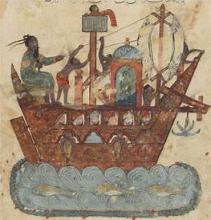by Kathryn Medill
On February 9th, Dr. Kristina Richardson of the University of Virginia gave the 2024 Ziadeh Lecture, which was organized by MELC’s Arabic and Islamic Studies unit. Richardson is an award-winning scholar who studies marginalized people groups of the medieval Islamic world, drawing on discourse around the concept of “blightedness,” an historical Islamic idea applying to persons with a wide variety of bodily differences from their societies’ norms, including mental and physical disability, sickness, blue eyes, and black skin.
For the Ziadeh Lecture, Richardson presented her current work, in which she strives to bring scholarly attention to the lives and experiences of East African slaves around the Persian Gulf, and attempts to recover their ethnic identities.
Richardson focuses on the people described as “Zanj,” who are often mentioned in Islamic medieval texts and depicted in their art. The Zanj people did many kinds of outdoor work, keeping and guarding date plantations and gardens; building massive irrigation works; caring for sheep, horses, and camels; drawing water from wells; and working on boats and docks. They were known for their ability to tell time by the stars—a necessity when practicing night irrigation for their owners in cooperation with the slaves of other estates—and for their agricultural knowledge.
The lot of the Zanj was not a happy one. After being collected on islands like Zanzibar and Pemba off the coast of modern Tanzania, tens of thousands of male East Africans were taken to the shores of the Persian Gulf. Often being worked night and day (to the point that at least one Islamic imam objected), they had a high mortality rate and children born to the enslaved community rarely survived, with the community only continuing because so many additional adult slaves were continually brought in.
Using the few ethnographic details available, Richardson has been able to identify at least one of the people groups that made up the Zanj: the Mashku (modern Makua), whose people in more recent times were enslaved and taken to Louisiana and Brazil. First, Richardson connected one of the gentilics used for the Zanj in the Islamic sources, Mechir, with the Majku of Persian sources, from which it is an easy step to modern Makua. Second, Richardson demonstrated that the few Zanj vocabulary words in Islamic sources are consistent with the Makua language, although as these words also appear in other Bantu languages this is not sufficient evidence by itself. Third, Richardson discussed the beautification practices of the Zanj as described in Islamic sources: a frequent use of tooth-sharpening, with some Zanj practicing tooth-pulling instead. These were both common practices in East Africa in the twentieth century, with tooth-sharpening being prevalent in coastal Tanzania and Mozambique, and pockets of tooth-pulling occurring farther inland (according to a study by Lignitz). This is the same area inhabited by the Makua, as well as other East African peoples. The rationales given for these practices by the Islamic Zanj are similar to those of the modern Makua: tooth-sharpening is connected with social cannibalism and tooth-pulling with the desire not to look like a sheep.
Richardson’s work brings valuable attention to a previously understudied people group, and pushes back against scholarly tendencies to view slavery in the Islamic world as “benign” and “elite.” Without the Zanj doing their denigrated agricultural work, the so-called Golden Age of the Abbasids would not have been possible.
This lecture was a wonderful addition to the Ziadeh Lecture tradition. Offered annually for over twenty years, the Ziadeh Lectures are named in honor of the MELC Department’s founder, Dr. Farhat Ziadeh, a scholar specializing in Islamic law and Arabic grammar. The Arabic and Islamic Studies unit is grateful for the Ziadeh family’s ongoing support for the department. We are also grateful for co-sponsorship for this year’s lecture from the Middle East Center and the PhD Program in Near and Middle Eastern Studies.
